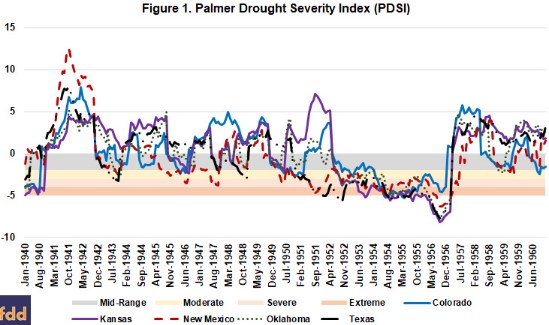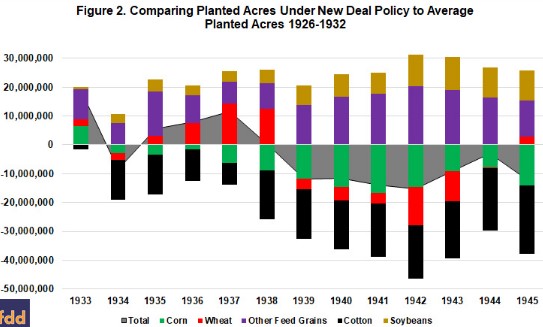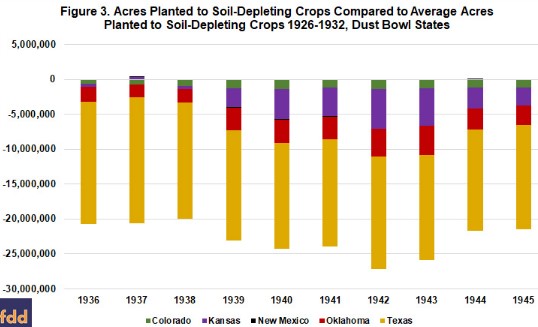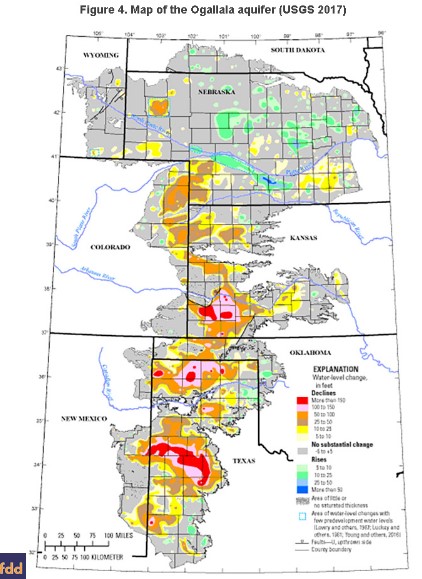By Jonathan Coppess
Drought continues to hit the Great Plains on a cyclical basis yet the region remains a key component of American agriculture, consisting of nearly 10% of national production. To date, the region has not, however, produced another Dust Bowl. The reasons for that, like the reasons for the Dust Bowl, are a combination of climatic cycles, human innovation and policies. Part 3 of this series reviews the southern Great Plains’ recovery from the Dust Bowl in search of lessons amidst settling dust.
Background
As discussed in the previous article, the Dust Bowl was built from policies, human activities and natural cycles. Specifically, the free land policy of the Homestead Act of 1862 and the Expanded Homestead Act of 1909 drove settlement and the breaking of native prairie for farming, but established acreages for homesteaders that were too small to be economically viable. In addition, homesteaders had little knowledge or experience about the climate west of the 100th meridian, bringing with them farm experience from the rain fed regions in the East or Europe. Compounding this lack of knowledge for the new farms, research and education was also lacking. The Extension service did not exist until Congress created it in 1914. The void was filled by railroad promoters, land speculators and similar interests with misguided advice or worse. When drought returned, the pulverized soils were exposed and primed for wind erosion and massive dust storms that dropped western soils on eastern cities (farmdoc daily, October 24, 2019). Major policy attempts at addressing the Dust Bowl catastrophe began in 1935 and 1936; the results of which continue to impact farming, policy and politics today.
Discussion
Drought is cyclical on the Great Plains and our experiences have been minor in the grand scheme of history; researchers have found at least four “megadroughts” during the previous 1,000 years that lasted for decades and estimated to have been far more extreme (Lee & Gill 2015). The drought of thirties—and thus the Dust Bowl—came to an end in the early 1940s with a return of above average rainfall (Lee & Gill 2015; Worster 2004; Hurt 1981). Figure 1 illustrates the Palmer Drought Severity Index for the years 1940 to 1960 (PDSI) for the southern Plains states. As discussed previously, the PDSI is a measurement of the duration and intensity of drought (farmdoc daily, October 24, 2019). Based on this measure, note that drought returned in the 1950s and that 1956 and early 1957 were worse than in 1934.

Setting aside climatic cycles, the human response to the Dust Bowl will be the focus of the discussion below. That response can be broken into three categories: (1) addressing the plow-up of native vegetation, including conservation and acreage reduction policies; (2) conservation efforts focused on research, education and demonstration to address the pulverization of topsoil; and (3) the role of technology and adaptation.
(1) Addressing the Plains Plow-up
The Dust Bowl can be attributed in part to the plowing under of more than 100 million acres of native vegetation. For policymakers looking for solutions in the swirling dust storms, efforts to reverse planting in the region would be a logical place to start. In 1934, Congress formally ended the homesteading policy of giving away free land with the Taylor Grazing Act (Hargreaves 1976). One recommendation from 1934 was for the purchase of 75 million acres that could be taken out of cultivation and production (Hurt 1985). Another recommendation was for the purchase of 6.5 million acres of cropland for conversion to grazing lands, with some of the lost revenues returned to the counties from federal grazing revenues (Lewis 1989). The 1936 report produced for President Franklin Roosevelt by the Great Plains Committee recommended that approximately 15 million acres in the Great Plains Dust Bowl region should be taken out of production and returned to permanent grassland (GPC Report 1936). Recommendations in hand, the Roosevelt Administration attempted innovative but controversial land use planning, reclamation and resettlement efforts with limited success. The effort was slow and struggled with insufficient funding. Implementation was also hampered because the authority passed thru an alphabet soup of New Deal agencies, from the Agricultural Adjustment Administration to the Resettlement Administration, then the Farm Security Administration before landing with the Soil Conservation Service in 1938 (Hurt 1986). Agencies struggled with reseeding damaged lands in the midst of drought and dust, as well as with controversies inherent in federal land purchases and resettlement. Approximately 11 million acres were eventually purchased, at a cost of $48 million, but research has found that little of it was reclaimed cropland. For example, only about one-third of the acres purchased in the northern Great Plains were actually cropland (Cunfer 2001). In the southern Great Plains—the center of the Dust Bowl—less than half of the acres purchased from 1938 to 1941 were cropland, while nearly 60% were rangelands (Hurt 1985). In 1953, these acres were transferred to the Forest Service and became the National Grasslands in 1960.
In 1936, the Supreme Court declared the Agricultural Adjustment Act of 1933 to be an unconstitutional exercise of Congressional power (Coppess 2018). Locked in the Depression and Dust Bowl, Congress combined conservation with the goal of reducing planted acres of over-supplied crops. It enacted the Soil Conservation and Domestic Allotment Act of 1936 about a month after the Supreme Court decision was handed down. In this legislation, Congress blended purposes, which included the “preservation and improvement of soil fertility,” the “promotion of the economic use and conservation of land” and “the diminution of exploitation and wasteful and unscientific use of national soil resources” with the “reestablishment . . . of the purchasing power of the net income per person on farms” by paying farmers to “encourage and provide for soil conserving and soil rebuilding practices rather than the growing of soil depleting commercial crops” (P.L. 74-461, 1936). Historians have raised the argument that conservation was more of a “device for cutting down production of the major cash crops and transferring income to farmers, without running afoul of the legal objections raised by the Supreme Court” with a “gentle shower of federal checks evenly and undiscriminatingly distributed over eroding and noneroding areas alike” (Benedict 1953, at 350-51). Figure 2 provides a review of planted acreage statistics from NASS Quick Stats (NASS). It compares the acres planted after the introduction of the New Deal farm policy to the average acres planted in the years leading up to the 1933 Act (e.g., average of acres planted in 1926 to 1932) by subtracting each year’s planted acres from the average.

Nationally, Figure 2 highlights that acreage did not decrease until after Congress wrote prescriptive acreage allotment requirements into the Agricultural Adjustment Act of 1938. It also highlights how the 1938 acreage allotments resulted in a reduction in planted acres but also significant shifts out of corn, cotton and wheat into other feed grains and soybeans. The 1936 Act sought to reduce planted acres of “soil depleting commercial crops” (i.e., corn, wheat and cotton), replacing them with grass or other soil-conserving crops. Figure 3 illustrates the changes in acres planted to the soil-depleting crops beginning in 1936 by comparing acres planted to those crops each year to the average acres planted to them from 1926 to 1932 (years before the 1933 AAA) for each of the Dust Bowl states (Colorado, Kansas, New Mexico, Oklahoma and Texas). Planted acreage data indicates that the 1936 program did reduce planted acres of these crops in the Dust Bowl states.
Figure 3 provides an incomplete picture. The NASS data includes increases in the planted acres of other feed grains (sorghum, oats and rye), as well as soybeans, in these years. Further review is needed to determine how many acres went into conservation cover versus other crops. At the very least, both the 1936 and 1938 Acts appear to have resulted in acreage shifting out of the crops in surplus but a better understanding of the effectiveness of the policy in addressing the Dust Bowl remains questionable.

When dust darkened the skies over DC, Hugh Hammond Bennett used the crisis as a lever to move Congress to provide authority and funding for soil conservation efforts (Egan 2006). The first effort was the Soil Conservation Act of 1935 which “recognized that wastage of soil and moisture resources on farm, grazing and forest lands of the Nation, resulting from soil erosion, is a menace to the national welfare” (P.L. 74-46, 1935). The 1935 Act created the Soil Conservation Service (SCS) in the U.S. Department of Agriculture and authorized appropriations for soil erosion control activities, including soil surveys and research, preventive measures, cooperative agreements and the ability to acquire lands or interests in lands. With the 1935 Act, Congress declared a national policy for the permanent “control and prevention of soil erosion” under the direction and coordination of the Secretary of Agriculture.
Under the leadership of Hugh Hammond Bennett, the SCS went to work on research and demonstration to farmers of soil conservation, which he argued was “probably the youngest of all the agricultural sciences” (Bennett 1943, at 170). This included revising farming practices, replacing the destructive pulverization of the dry farming method with soil listing, furrows to reduce wind erosion and hold moisture. SCS also undertook more significant practices with farmers such as contouring farming and terracing of fields to help reduce erosion and retain moisture, as well as help with plant growth. Research indicates some success as a result of these efforts with a 65% to 70% reduction of serious wind erosion by 1937, but that Congressional appropriations consistently fell short of the need (Worster 2004; Hurt 1981). It appears that herculean efforts by SCS, researchers, Extension and farmers helped combat some of the worst of wind erosion in the Dust Bowl region, at least until the rains returned and irrigation technology came along.
In addition to technical and financial conservation assistance, the New Deal efforts also set in motion a long-running, far-reaching experiment in combining federal and local governance that has mostly survived into current times. Created out of the 1935 Act’s requirement for safeguarding state and local land use laws in the push for addressing soil erosion, USDA drafted model legislation for states to enact that would create Soil Conservation Districts. Arkansas was the first state to adopt the model legislation in March 1937; by the end of 1939, thirty-six states had enacted some form of the model legislation and all states had complied by 1945 (Worster 2004; Massey 1983; Morgan 1965; Walker & Parks 1946). In general, USDA’s Soil Conservation Service conditioned the receipt of financial assistance for conservation on the state having enacted the model law; the model law provided significant land use regulatory power to the districts at the local level—although many states modified these provisions—and were generally designed to coordinate advice, technical assistance and other conservation-related activities on private lands, as well as deliver financial assistance (Milde 1951). This was a major innovation in policy, program administration and government by the New Deal built on goals for decentralization, local self-determination and the combined expertise, experience and knowledge of specialists, scientists and farmers in land use decisions (Morgan 1965; Walker & Parks 1946).
(3) Making It Rain on the Plains: Irrigation Technology
Acreage reduction and reclamation had limited and questionable results for addressing the Dust Bowl. Conservation policies and efforts certainly provided for improved farming practices and helped cut down wind erosion but they were also inadequately funded and relatively limited; the return of a wetter climate cycle was the biggest factor. In terms of human activity, however, the single biggest impact in helping avoid another Dust Bowl thus far has been the widespread adoption of irrigation technology. Specifically, the adaptation of wartime mechanical advances to withdraw water from the Ogallala aquifer. Figure 4 is a map of the Ogallala aquifer from the U.S. Geological Survey (USGS 2017). In addition to highlighting how the Ogallala is located over the western Great Plains—and, in particular, the center of the Dust Bowl—the USGS map also indicates the substantial and troubling decline in water levels for much of the aquifer.

The Ogallala is one of the world’s largest sources of underground freshwater; filled by ancient runoff from the Rocky Mountains, it was discovered in the 1890s and is estimated to support nearly 10% of U.S. agricultural production (Lauer et al. 2018; Hornbeck & Keskin 2014). Deep underground in most places, it required the development of better pumping and center pivot technology after World War II—helped by adapting engines no longer needed for the war—to make it rain on the Plains at the command of farmers. Research has concluded that the slow rate of recharge for the aquifer makes it a non-renewable resource; usage surpassed the recharge rate as “groundwater withdrawals quintupled from 1949 to 1974 and water tables have declined substantially from predevelopment levels” in a classic tragedy of the commons scenario (Hornbeck & Keskin 2014, at 193). It did, however, make the difference when drought returned in the 1950s and has thus far largely stood between farming and another Dust Bowl.
Concluding Thoughts
As historical analogue, the Dust Bowl has much to offer; the lessons for policy in anticipation of a changing climate are difficult to parse and understand. The Dust Bowl was built when the climatic cycle returned drought to the region, colliding with human-induced changes on the land. Settlers had plowed under the native vegetation. Farmers pulverized the soil due to a combination of inexperience and bad advice. All of it was set in motion by homesteading policy. Recovery came about foremost because the cycle returned sufficient precipitation for plant growth. Conservation policy and human efforts to combat soil erosion helped before the rains returned. Ultimately, however, it was a technological innovation in the form of center pivot irrigation that has thus far largely prevented another Dust Bowl. This innovation, however, involves extracting a non-renewable resource. This fact carries troubling portents for a future where climate change is expected to upend our best understandings of, and experience with, the weather and climatic cycles of the region. In short, there is not another Ogallala to tap into—and much less of the current one to rely on—in the future. The most important lessons to take from the Dust Bowl recovery are those involving conservation and adaptation.
Source : illinois.edu